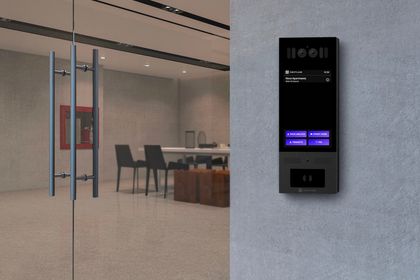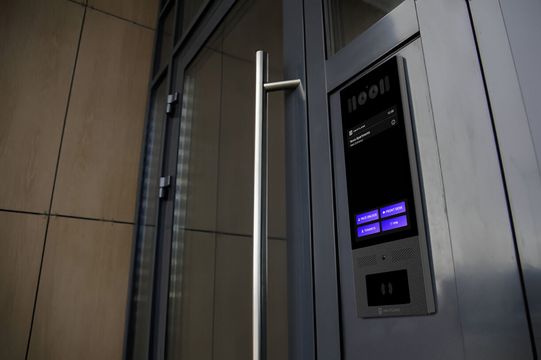Residential and commercial buildings today need access control solutions like modern intercoms to help manage the flow of traffic into the building while keeping occupants and property secure. For many buildings, Wi-Fi-based intercom systems have become the go-to choice. They install easily in both new construction and existing buildings with minimal fuss and without complicated wiring.
In this article, we cover the ins and outs of Wi-Fi intercoms for both home and business use. We explore how they operate, their pros and cons compared to other types of intercoms, and key features you’ll want to look for, besides Wi-Fi connectivity.
In the end, we look at some Wi-Fi intercoms that can work for residential buildings, offices, and gated communities.
Table of Contents
- Introduction to Wi-Fi-Based Intercom Systems
- Wi-Fi Intercoms Vs. Other Connectivity Methods
- Pros and Cons of Wi-Fi Intercoms
- Choosing the Right Intercom System for your Building Type
- Best Wi-Fi Intercoms
- Cellular Wireless Alternative for Buildings Without Wi-Fi
- Frequently Asked Questions for Wi-Fi Intercoms
Introduction to Wi-Fi-Based Intercom Systems
A Wi-Fi intercom system is a type of wireless communication device that uses a building’s Wi-Fi network (rather than physical wiring or a cellular data connection) to connect different units, doors, or stations together for two-way audio and/or video communication. Wi-Fi intercoms have become a popular choice for connecting building front doors, main gates, and parking gates to building residents or office tenants as an access control solution.
Unlike wired intercom systems, which only operate within a local area network (LAN), Wi-Fi systems generally connect to the Internet and are a subcategory of Internet Protocol (IP) intercoms. Other types of IP intercoms include those with cellular data connectivity (4G, LTE) or a wired Ethernet connection to a router or modem. IP intercoms can include capabilities such as remote management, mobile access, and video streaming. Wi-Fi intercoms utilize the building’s Wi-Fi network to offer these features.
Key Characteristics of a Wi-Fi Intercom System
- Wireless installation: There’s no need to run wires for communication throughout the building. Units connect through the building’s existing Wi-Fi network.
- Mobile connectivity: Most Wi-Fi intercoms allow residents or users to answer calls, see visitors, and unlock doors remotely from their smartphones or tablets using a dedicated app.
- Audio and video options: Many models offer both speaking and video streaming features, which allow for visual verification of who is at the door.
- Cloud storage and remote access: Some systems store video footage in the cloud and allow for remote access, making them a great option for multi-tenant buildings.
- Flexible for retrofits: Since they don’t require new wiring or backwards compatibility with older wiring, they are useful in older buildings where installing new wiring would be costly or disruptive.
Common Use Cases for Wi-Fi Intercoms
- Apartment and condo/co-op front-door visitor access
- Gated community entrances for both cars and pedestrians
- Single-family homes that want a remote unlock feature
- Small offices and businesses
Here’s an example of a Wi-Fi intercom in action: A delivery person presses a button at your building’s entrance panel. Instead of hearing the ring inside only, the call is relayed via Wi-Fi to the Internet, so it reaches you, the building resident or tenant, wherever you are located. You can see the delivery person on an app, speak with them, and even remotely unlock the door if needed.
Wi-Fi Intercoms Vs. Other Connectivity Methods
Wi-Fi intercoms represent an alternative connection to several other types of intercom connections:
Cellular/Mobile Data
These intercoms are the most similar to Wi-Fi intercoms. They connect to the Internet just like a smartphone by connecting with the nearest cell tower provided by a mobile service provider. The intercoms connect using services like LTE or 5G. Like Wi-Fi intercoms they are wireless and Internet-enabled.
Ethernet
These intercoms connect to the Internet with a wired connection to an internet modem. Many such intercoms also feature Power over Ethernet (PoE), which means the intercom gets both its power and digital connectivity through a single Ethernet cable, helping to simplify installation. This method tends to be the most popular for multi-tenant buildings because Ethernet offers a more robust and interference-proof connection compared to those using Wi-Fi or cellular connections alone.
Telephone Call Boxes
These intercoms plug into an ordinary telephone landline and route audio-only calls over the phone network. The intercom simply calls the resident’s phone number. The resident can answer on their home landline phone or a cell phone.
Wired Intercoms
Some intercoms don’t connect to the Internet or telephone network at all. These intercoms are wired individually to each residence on a dedicated wire only within the building, a type of local area network. These intercoms don’t support features like a cloud-based management platform, data storage, or the ability for tenants to answer calls remotely.
Multiple Connection Methods
Many intercoms today feature multiple connectivity methods. So a Wi-Fi intercom could feature one of these other technologies as a backup. For instance, a Wi-Fi intercom may offer a cellular data connection as a backup in case the Wi-Fi goes down.
Pros and Cons of Wi-Fi Intercoms
Advantages of Wi-Fi Intercoms
Wi-Fi intercoms have become a go-to solution for many buildings, offering certain advantages over other connectivity methods.
- They easily connect to the Internet with no wires if the building already has a Wi-Fi network installed and operating.
- Wi-Fi today can offer ultra-fast digital signals that provide full-color HD video and crystal-clear VoIP audio with specialized wiring.
- There are no expensive dedicated landline phone services to maintain. The intercom can share the same Wi-Fi network with other devices.
- Wi-Fi intercoms can be a great option for outdoor pedestrian gates and parking entrances that are located away from indoor wiring or the modem.
Potential Wi-Fi Intercom Drawbacks
Wi-Fi intercoms have some potential disadvantages, though these are often solved if the intercom offers a backup connectivity method.
- Intercom connectivity can go down during an Internet or power outage (look for systems with power backups and cellular connectivity backup.
- Wi-Fi can be subject to rare interference or dead spots in buildings if a strong network connection or mesh network is not established.
- Wi-Fi cannot deliver power to the Intercom. People prefer an Ethernet-connected intercom because it can deliver both power and Internet via the same wire.
Choosing the Right Intercom System for your Building Type
Selecting the right intercom system depends largely on your building type and its specific access control needs. For single-family homes, a Wi-Fi-based intercom system like the Aiphone JOS-1VW is ideal. A system like that offers video, remote unlock, and mobile alerts with minimal installation effort. Small offices and businesses benefit from compact, professional-looking models like the DoorBird D1101V, which combine high-quality video with cloud integration and smart platform compatibility.
For multi-tenant buildings or gated communities, a more robust solution is required, such as one with Ethernet or cellular connectivity for greater reliability and advanced management features. In such cases, systems like the Swiftlane Swiftreader X provide remote administration, multiple credential options (facial recognition, fobs, PINs), and 24/7 support. Matching your system’s capabilities to the complexity and size of your building ensures better security, smoother visitor management, and a more future-proof investment.
We discuss these specific intercom models below.
Best Wi-Fi Intercoms
Wi-Fi Intercom for Small Businesses
DoorBird – D1101V IP Video Door Station
Manufacturer: DoorBird is a German company that specializes in IP-based (networked) access control solutions for homes and businesses.
Model Description: The DoorBird D1101V is a compact, stylish, Wi-Fi-enabled video door station designed for single-family homes or small offices.
Key Features: It offers full HD video streaming with night vision, two-way voice communication, visitor history with images stored locally or optionally in the cloud, and support for multiple user devices. In addition to Wi-Fi, it can connect over a wired LAN via Ethernet. It also integrates with smart home platforms like Control4 and Savant.
Why We Like It: The intercom features a sleek stainless steel design with a weatherproof IP65 rating, which looks professional, especially for a business setting. However, you can choose from among six different metallic finishes or 18 alternative colorways to suit your particular home or building. It maintains visitor image storage for free, which is great for an individual household or a small single business without adding to costs.
Wi-Fi Intercom for Single Family Homes
Aiphone JOS-1VW Video Intercom System
Manufacturer: Aiphone Co., Ltd. is a Nagoya, Japan-based intercom company. Widely known for telephone call box style intercoms, the company also makes IP-based intercoms.
Model: JOS-1VW is a Wi-Fi Video Intercom Kit (includes door station and touchscreen monitor), which communicates over the home’s Wi-Fi network to connect a front door or gate with the touchscreen monitor inside.
Key Features: The Aiphone JOS-1VW offers high-resolution video and mobile app support—enabling users to answer calls, view visitors, and unlock doors remotely using their smartphones in addition to the touchscreen monitor mounted in their home. A 7-inch touchscreen indoor monitor provides clear live video of visitors and intuitive controls for answering calls, unlocking doors, and adjusting settings. Meanwhile, the outdoor intercom has a built-in camera, microphone, speaker, and doorbell.
Why We Like It: The set up comes easy for residential do-it-yourselfers seeking everything needed in one box. The Aiphone app also gets decent ratings, 4.2-stars in Apple App Store and 3.8-stars in the Google Play store. It’s an easy-to-use and professional-grade model from a trusted brand.
Cellular Wireless Alternative for Buildings Without Wi-Fi
To enjoy the relative ease of a wireless intercom in buildings that lack a building-wide Wi-Fi network or strong Wi-Fi near the intercom placement, cellular-based intercoms can offer a powerful alternative.
Swiftlane SwiftReader X
The Manufacturer: Swiftlane is a San Francisco-based provider of access control solutions for multi-family residential buildings, office buildings, college campuses, salon suites, gyms, and gated communities.
Model Description: The Swiftlane Swiftreader X is the company’s IP model with LTE cellular connectivity in addition to Ethernet connectivity with PoE, offering two great connectivity methods as an alternative to Wi-Fi. It has IP65 and IK10 certification for all weather conditions and outdoor settings, making it suitable for rugged outdoor installations.
Key Features: The Swiftreader X features an 8-inch HD touchscreen and two-way video that connects with tenants via the Swiftlane app. Building managers or condo boards can add and remove tenants easily via the Swiftlane cloud-based management platform, including multiple intercoms, door strikes, gates, and fob readers all in one place. Swiftlane intercoms are best known for their facial recognition access control, but can also work with PINs, key fobs, and mobile devices.
Why It Stands Out: Swiftlane has very high resident satisfaction as reflected in ratings for the Swiftlane app on the Apple App Store (4.8 stars) and the Google Play store (4.7 stars). The devices features 24/7 live support and a two-year manufacturer warranty.
Frequently Asked Questions for Wi-Fi Intercoms
How does a Wi-Fi intercom system work?
A Wi-Fi intercom system works by connecting devices like door stations, indoor monitors, and mobile phones through the building’s Wi-Fi network. When someone presses the intercom button, the system sends a signal through the Internet, allowing you to receive a notification on your device. From there, you can see and talk to the visitor in real time, and in many cases, you can remotely unlock a door without being physically present in the building.
Do I need an internet connection for a Wi-Fi intercom to work?
Yes, an internet connection is necessary for a Wi-Fi intercom system to function properly. The system relies on a stable Wi-Fi network to transmit audio, video, and access commands. Without internet access, intercoms lose remote functionality, and in some systems, even local communication can fail. The intercom can connect to the individual Wi-Fi of a single family home or individual business, or to building-wide Wi-Fi in a multitenant building.
Can I use my smartphone to answer a Wi-Fi intercom?
Yes, you can easily use your smartphone to answer calls from a Wi-Fi intercom. Most modern systems come with a dedicated mobile app that you install on your phone. Through the app, you can receive live notifications, view a video of the visitor, and have a conversation with them.
Are Wi-Fi intercom systems secure?
Wi-Fi intercom systems are very secure if they are properly configured and maintained. To ensure security, it’s important to use strong passwords on your Wi-Fi network, keep the system’s firmware up to date, and choose a model that encrypts audio and video transmissions. Some systems also offer additional protections like two-factor authentication to enhance app security.
How reliable are Wi-Fi intercom systems?
The reliability of a Wi-Fi intercom system largely depends on the quality of your Internet connection. When Wi-Fi is strong and stable, these systems perform very well. However, if your network is weak, overloaded, or prone to outages, you may experience problems like dropped calls, delayed video, or failed remote unlocking commands. Reliability can approach 100% if the intercom has a backup connectivity method.
Can Wi-Fi intercoms be installed outdoors?
Yes, many Wi-Fi intercom systems are designed for outdoor installation, which is useful for connecting the Wi-Fi without running outdoor digital wiring. However, it’s important to choose a model specifically rated for outdoor use, often indicated by weatherproof certifications like IP65 or higher. Choose an outdoor-rated intercom to resist rain, dust, and temperature extremes. These factors make them suitable for gates, driveways, and exterior entryways. Also, check the intercom’s IK rating, which is its durability against vandalism. Prefer IK08, IK09, and IK10 ratings for outdoor settings.
What happens if the Wi-Fi or Internet goes down?
If your Wi-Fi or internet service goes down, most Wi-Fi intercom systems will lose their ability to function. In such cases, you won’t be able to receive calls or unlock doors remotely. Some high-end models can continue to operate locally over a closed internal network (LAN), but remote access will still be unavailable until the internet connection is restored. If continuous access is critical, it may be worth considering systems that have cellular backup capabilities. Even when the Internet is down, residents and tenants can still get into their buildings using ordinary keys, key fobs, PIN codes, or Bluetooth connections from their mobile device.
Is a Wi-Fi intercom easy to install?
Installing a Wi-Fi intercom system is usually straightforward and considered DIY-friendly. Most models involve physically mounting the device, connecting it to a power source, and then linking it to your Wi-Fi network using a mobile app. Some devices for single family homes use existing doorbell wiring, while others plug into a standard outlet. However, if your system is integrated with an electric door strike or magnetic lock for remote unlocking, some light electrical work may be required that requires a professional.
Can other devices use the same Wi-Fi
Yes, a Wi-Fi network can be shared across multiple devices including a Wi-Fi intercom. In other words, a Wi-Fi intercom does not require a dedicated Wi-Fi network. It can use a preexisting network that may be used by other equipment in the building.
How much does a Wi-Fi intercom system cost?
The cost of a Wi-Fi intercom system can vary quite a bit depending on its features and use case. For individual homes or businesses, basic models, which often include video capabilities, typically cost between $200 and $500. More advanced systems designed for multi-tenant buildings or commercial properties can cost $1,000 or more, especially when factoring in additional features like cloud storage subscriptions, professional monitoring, or mobile access for dozens or hundreds of users.








